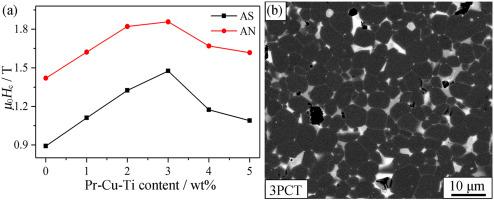Journal of Rare Earths ( IF 4.9 ) Pub Date : 2021-02-13 , DOI: 10.1016/j.jre.2021.02.007 Jinhao Zhu 1, 2 , Guangfei Ding 1 , Bo Zheng 1 , Haichen Wu 3 , Lei Jin 1 , Zhehuan Jin 1 , Shuai Guo 1, 2 , Renjie Chen 1, 2 , Aru Yan 1, 2

|
By intergranular addition of Pr-Cu-Ti alloy powders in the Nd-Fe-B sintered magnets with the normal B component, we propose an approach to the optimization of grain boundary and local Nd-Fe-B composition system. The coercivity is enhanced from 1.42 to 1.86 T, while further addition leads to a reduction in remanence and coercivity. The analyses of phase composition reveal that Ti mainly exists in the form of metallic Ti alloy, and part of Ti combines with B to form the TiB2 phase after the liquid phase sintering process. This process results in a consumption of B in the local Nd-Fe-B composition system and a change of the grain boundary component, which contributes to the formation process of the RE6(Fe,M)14 phase after the annealing process. Therefore, with the modification of grain boundary and composition system, the intergranular addition of Pr-Cu-Ti induces the generation of continuous thin grain boundary phases. It promotes the intergrain exchange decoupling, increasing the coercivity in the annealed magnet. While the excess addition results in the segregation of TiB2, as well as the precipitation of TiB2 into the Nd-Fe-B phase, which leads to structural defects. Thus, the further effort for the addition alloy with Ti to reduce the deterioration of the microstructure will lead to further improvement in magnetic properties.
中文翻译:

Pr-Cu-Ti晶间添加对无重稀土Nd-Fe-B烧结磁体组织和磁性能的影响
通过在具有正常 B 成分的 Nd-Fe-B 烧结磁体中晶间添加 Pr-Cu-Ti 合金粉末,我们提出了一种优化晶界和局部 Nd-Fe-B 成分体系的方法。矫顽力从 1.42 T 提高到 1.86 T,而进一步添加导致剩磁和矫顽力降低。相组成分析表明,Ti主要以金属Ti合金的形式存在,液相烧结后部分Ti与B结合形成TiB 2相。该过程导致局部Nd-Fe-B成分体系中B的消耗和晶界成分的变化,这有助于RE 6 (Fe,M) 14的形成过程退火过程后的阶段。因此,随着晶界和成分体系的改变,Pr-Cu-Ti的晶间添加诱导了连续薄晶界相的产生。它促进晶间交换去耦,增加退火磁体的矫顽力。而过量添加导致TiB 2偏析,以及TiB 2析出到Nd-Fe-B相中,从而导致结构缺陷。因此,进一步努力添加钛合金以减少微观结构的劣化将导致磁性能的进一步改善。



























 京公网安备 11010802027423号
京公网安备 11010802027423号